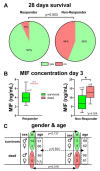Macrophage Migration Inhibitory Factor (MIF) Plasma Concentration in Critically Ill COVID-19 Patients: A Prospective Observational Study
- PMID: 33671433
- PMCID: PMC7922575
- DOI: 10.3390/diagnostics11020332
Macrophage Migration Inhibitory Factor (MIF) Plasma Concentration in Critically Ill COVID-19 Patients: A Prospective Observational Study
Abstract
Mortality in critically ill coronavirus disease 2019 (COVID-19) patients is high and pharmacological treatment strategies remain limited. Early-stage predictive biomarkers are needed to identify patients with a high risk of severe clinical courses and to stratify treatment strategies. Macrophage migration inhibitory factor (MIF) was previously described as a potential predictor for the outcome of critically ill patients and for acute respiratory distress syndrome (ARDS), a hallmark of severe COVID-19 disease. This prospective observational study evaluates the predictive potential of MIF for the clinical outcome after severe COVID-19 infection. Plasma MIF concentrations were measured in 36 mechanically ventilated COVID-19 patients over three days after intensive care unit (ICU) admission. Increased compared to decreased MIF was significantly associated with aggravated organ function and a significantly lower 28-day survival (sequential organ failure assessment (SOFA) score; 8.2 ± 4.5 to 14.3 ± 3, p = 0.009 vs. 8.9 ± 1.9 to 12 ± 2, p = 0.296; survival: 56% vs. 93%; p = 0.003). Arterial hypertension was the predominant comorbidity in 85% of patients with increasing MIF concentrations (vs. decreasing MIF: 39%; p = 0.015). Without reaching significance, more patients with decreasing MIF were able to improve their ARDS status (p = 0.142). The identified association between an early MIF response, aggravation of organ function and 28-day survival may open future perspectives for biomarker-based diagnostic approaches for ICU management of COVID-19 patients.
Keywords: COVID-19; Horowitz Quotient; ICU treatment; Macrophage Migration Inhibitory Factor (MIF); SOFA Score; acute respiratory distress syndrome (ARDS).
Conflict of interest statement
The authors declare no conflict of interest.
Figures






Similar articles
-
Elevated MIF-2 levels predict mortality in critically ill patients.J Crit Care. 2017 Aug;40:52-57. doi: 10.1016/j.jcrc.2017.03.012. Epub 2017 Mar 16. J Crit Care. 2017. PMID: 28329734
-
High postoperative blood levels of macrophage migration inhibitory factor are associated with less organ dysfunction in patients after cardiac surgery.Mol Med. 2012 Jul 18;18(1):843-50. doi: 10.2119/molmed.2012.00071. Mol Med. 2012. PMID: 22526918 Free PMC article.
-
Mesenchymal stem cells derived from perinatal tissues for treatment of critically ill COVID-19-induced ARDS patients: a case series.Stem Cell Res Ther. 2021 Jan 29;12(1):91. doi: 10.1186/s13287-021-02165-4. Stem Cell Res Ther. 2021. PMID: 33514427 Free PMC article. Clinical Trial.
-
[Dynamic measurement of volume of atelectasis area in the evaluation of the prognosis of patients with moderate-to-severe acute respiratory distress syndrome].Zhonghua Wei Zhong Bing Ji Jiu Yi Xue. 2020 Sep;32(9):1056-1060. doi: 10.3760/cma.j.cn121430-20191219-00056. Zhonghua Wei Zhong Bing Ji Jiu Yi Xue. 2020. PMID: 33081890 Chinese.
-
Hospital Resources May Be an Important Aspect of Mortality Rate among Critically Ill Patients with COVID-19: The Paradigm of Greece.J Clin Med. 2020 Nov 20;9(11):3730. doi: 10.3390/jcm9113730. J Clin Med. 2020. PMID: 33233686 Free PMC article.
Cited by
-
A Potential Association between Ribonuclease 1 Dynamics in the Blood and the Outcome in COVID-19 Patients.Int J Mol Sci. 2023 Aug 4;24(15):12428. doi: 10.3390/ijms241512428. Int J Mol Sci. 2023. PMID: 37569802 Free PMC article.
-
Identifying novel host-based diagnostic biomarker panels for COVID-19: a whole-blood/nasopharyngeal transcriptome meta-analysis.Mol Med. 2022 Aug 3;28(1):86. doi: 10.1186/s10020-022-00513-5. Mol Med. 2022. PMID: 35922752 Free PMC article.
-
Suppressed transcript diversity and immune response in COVID-19 ICU patients: a longitudinal study.Life Sci Alliance. 2023 Nov 2;7(1):e202302305. doi: 10.26508/lsa.202302305. Print 2024 Jan. Life Sci Alliance. 2023. PMID: 37918965 Free PMC article.
-
Analyzing network diversity of cell-cell interactions in COVID-19 using single-cell transcriptomics.Front Genet. 2022 Aug 29;13:948508. doi: 10.3389/fgene.2022.948508. eCollection 2022. Front Genet. 2022. PMID: 36105110 Free PMC article.
-
The Role of MIF and IL-10 as Molecular Yin-Yang in the Modulation of the Host Immune Microenvironment During Infections: African Trypanosome Infections as a Paradigm.Front Immunol. 2022 Apr 7;13:865395. doi: 10.3389/fimmu.2022.865395. eCollection 2022. Front Immunol. 2022. PMID: 35464430 Free PMC article. Review.
References
-
- Mao R., Qiu Y., He J.S., Tan J.Y., Li X.H., Liang J., Shen J., Zhu L.R., Chen Y., Iacucci M., et al. Manifestations and prognosis of gastrointestinal and liver involvement in patients with COVID-19: A systematic review and meta-analysis. Lancet Gastroenterol. Hepatol. 2020;5:667–678. doi: 10.1016/S2468-1253(20)30126-6. - DOI - PMC - PubMed
-
- Zhou F., Yu T., Du R., Fan G., Liu Y., Liu Z., Xiang J., Wang Y., Song B., Gu X., et al. Clinical course and risk factors for mortality of adult inpatients with COVID-19 in Wuhan, China: A retrospective cohort study. Lancet. 2020;395:1054–1062. doi: 10.1016/S0140-6736(20)30566-3. - DOI - PMC - PubMed
-
- Grasselli G., Zangrillo A., Zanella A., Antonelli M., Cabrini L., Castelli A., Cereda D., Coluccello A., Foti G., Fumagalli R., et al. Baseline Characteristics and Outcomes of 1591 Patients Infected With SARS-CoV-2 Admitted to ICUs of the Lombardy Region, Italy. JAMA. 2020;323:1574–1581. doi: 10.1001/jama.2020.5394. - DOI - PMC - PubMed
Grants and funding
LinkOut - more resources
Full Text Sources
Other Literature Sources
Medical
Miscellaneous

